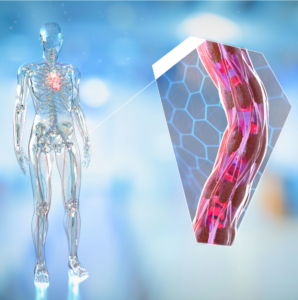Angiocrine Bioscience’s technology is based on key breakthroughs in vascular biology and stem cell research.
What are endothelial cells (ECs)?
The blood vessels can be considered forming the largest organ in the body and course through every part of the human body. The inner lining of blood vessels is composed of endothelial cells. The smallest of the blood vessels, the capillaries, are composed only of endothelial cells. Capillaries form vascular networks within virtually every organ and thus are vital for normal functioning of organs and a healthy, active life.
Why are endothelial cells so important?
During embryonic development, specialized endothelial cells lead organ development.
In adulthood, endothelial cells in capillaries not only play a critical role in keeping organs functioning and healthy, but also serve an active role in repairing tissue damage by expressing a complex mixture of reparative angiocrine factors. Importantly, virtually every organ contains progenitor (stem) cells alongside its capillaries, forming what is known as the vascular ‘stem cell’ niche.
When a person sustains bodily damage from injury of diseases, the endothelial cells within the niche respond by expressing ‘reparative’ angiocrine factors that guide the neighboring progenitor cells to repair the damaged tissue in the organ.
Successful tissue growth and repair must be coordinated with vessel growth.
What are vascular niches?
Endothelial cells and adult progenitor (stem) cells congregate to form vascular ‘stem cell’ niches. These niches have been found in nearly all tissues and organs. Within the vascular niche, the endothelial cells maintain the organ’s progenitor (stem) cells by expressing ‘maintenance’ angiocrine factors. In some organs, the vascular niches are very active in health. For example, the human body renews the lining of the mouth and the gastro-intestinal (GI) tract on a daily basis. This renewal is produced by the vascular niches in our GI tract. The bone marrow produces billions of cells on a daily basis—another example of very active vascular niches. Other organs like the brain have less active niches; however, the human body retains the capacity to repair and heal virtually every organ through its organ vascular ‘stem cell’ niches.
How does the human body naturally repair itself?
In mammals, although regeneration is quite restricted to a number of tissues and organs, this particular healing process is possible through the existence of tissue-resident stem/progenitor cells and the vascular ‘stem cell’ niche. Upon injury, tissue resident progenitors are activated, they proliferate, migrate, and differentiate into tissue-specific cells and functionally replace the damaged or lost cells. Besides this, blood vessels, especially the micro-vessels within organs, play crucial roles in tissue repair. Endothelial cells, which line blood vessels, together with the resident surrounding cells create a vascular ‘stem cell’ niche which is central to local and distant signaling thereby shaping the reparative and healing process. The signaling from the niche endothelial cells are in the form of angiocrine factors, which can number into the hundreds, are expressed dynamically, and in a two-way communication with the tissue progenitors in the niche.
Why don’t we heal well as we get older?
We all know that children have remarkable ability to heal quickly, while our grandparents don’t. In the last two decades, scientists (including ours at Angiocrine) have found that the activity of the body’s vascular niches become diminished as we get older, and often get completely disabled with multitude of diseases. Although both the endothelial cells and the stem cells both diminish with age, it is the former—i.e., endothelial—cells that are most affected with aging. Scientists have shown that age-dependent endothelial dysfunction occurs even in ‘healthy’ elderly people as well as ‘healthy’ aged animals.


